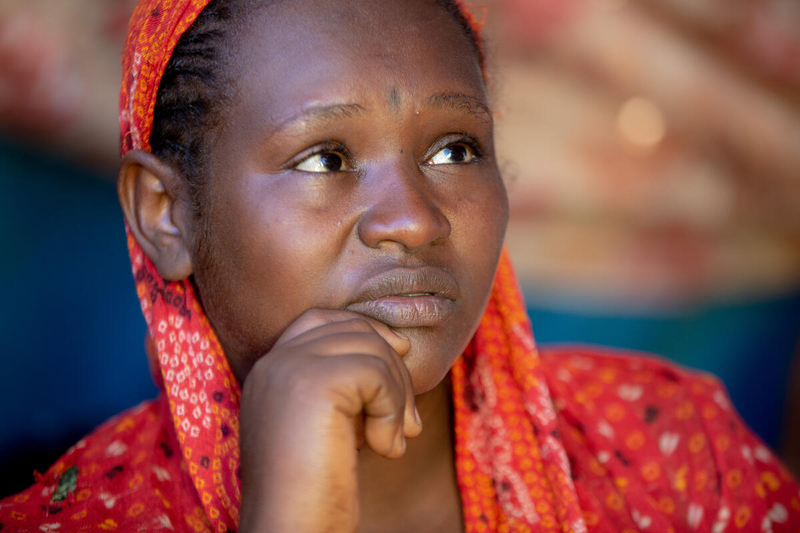
WFP Resumes Operations to Reach 2 Million People With Emergency Food Assistance in Tigray
ADDIS ABABA – The United Nations World Food Programme (WFP) has resumed its operations in the Tigray region of Ethiopia after fighting halted the emergency response last week. However serious challenges are threatening the entire humanitarian response in the region.
On Thursday, the U.N. World Food Programme reached 10,000 people displaced by conflict with emergency food assistance in the Adi Nebried area and gave nutritionally fortified food to 3,000 women and children, many suffering from malnutrition, in Endabaguna. The U.N. World Food Programme continues distributions today, hoping to reach 30,000 people in Northwest Tigray by the weekend.
“We have the teams on ground, trucks loaded and ready to go to meet the catastrophic food needs in the region. What we need now is free, unfettered access and secure passage guaranteed by all parties to the conflict so we can deliver food safely,” said Tommy Thompson, the U.N. World Food Programme’s Emergency Coordinator based in Mekelle.
Families are receiving some of the last of the U.N. World Food Programme’s food stocks. Lives will be lost if supply routes into Tigray do not fully open and parties to the conflict continue to disrupt or endanger free movement of cargo for the U.N. World Food Programme and other emergency responders. Two major bridges leading into Tigray from Gondar were destroyed on Thursday.
While the U.N. World Food Programme is adjusting its supply lines and exploring alternative routes into Tigray, the destruction of the bridges had an immediate impact on moving food into the region from Gondar. The U.N. World Food Programme requires safety and security for our staff, our partners, the people we serve and the assistance we provide to reach millions of people in need of emergency food and nutrition support when hunger peaks in the coming months.
No U.N. World Food Programme flights for UN and Non-Governmental Organization humanitarian staff have been authorized and civilian flights to Tigray have been stopped by the Ethiopian aviation authority since June 22, meaning humanitarian staff cannot be rotated in and out of Tigray by air. Banks are closed, and fuel and electricity are in short supply.
Additional information for journalists:
- The U.N. World Food Programme distributed food yesterday to almost 10,000 people in Adi Nebried two days after armed groups left the area and a day after heavy rains. By the end of today, the U.N. World Food Programme will have reached 30,000 people at risk of starvation, with lifesaving food and nutrition assistance. Fighting halted humanitarian operations in Tigray from June 24. The U.N. World Food Programme’s operations were however only fully stopped for two days before resuming on Thursday.
- The U.N. World Food Programme is assessing the security of two more areas in the northwest–Sheraro and Asgede–to establish if distributions can be resumed there. The U.N. World Food Programme is supporting food assistance partners to conduct security assessments with the aim of also resuming their humanitarian operations as soon as possible.
- The U.N. World Food Programme is responsible for providing emergency food assistance across the Northwestern and Southern zones of Tigray and must respond to growing needs in the region. The U.N. World Food Programme aims to reach 2.1 million people and has so far reached 1.2 million with emergency food assistance in round one and a further 500,000 in round two so far.
- The U.N. World Food Programme is at the forefront of the emergency nutrition response across Tigray with partners and is scaling up to reach people in as many as 70 woredas or districts. The U.N. World Food Programme has delivered 510,000 emergency nutrition rations to children and women since February in 43 woredas. In June, the U.N. World Food Programme reached almost 180,000 children and pregnant or nursing women in all zones across Tigray except for Western.
- The U.N. World Food Programme has expanded its warehouse capacity in Gondar, Kombolcha and Mekelle to a total storage capacity of between 60,000 to 70,000 metric tons. If security stabilizes, the Mekelle and Shire hubs will also be hubs from where assistance is dispatched to cover needs in other areas as well as providing storage in case access is reduced. About 15 U.N. World Food Programme trucks are to be deployed to Shire.
- A total of 5.2 million people, 91 percent of Tigray’s population, need emergency food assistance due to conflict since last November.
- The latest Integrated Food Security Phase Classification (IPC) analysis in June found 350,000 people in Tigray suffering from catastrophic levels of hunger (IPC 5). Across the region, 4 million people—70 percent of the population—are experiencing high levels of acute food insecurity (IPC 3 or above).
- Tigray’s farmers have missed the peak planting month of June due to shortages of seeds and fertilizer, therefore the main harvest in September will be impacted and it is highly likely large numbers of people will need continued emergency food assistance and nutrition support into 2022.
- The U.N. World Food Programme needs $176 million to continue scaling up its response in Tigray to save lives and livelihoods through to the end of this year.
Note to the editor
Photos available here
# # #
The United Nations World Food Programme is the 2020 Nobel Peace Prize Laureate. We are the world’s largest humanitarian organization, saving lives in emergencies and using food assistance to build a pathway to peace, stability and prosperity for people recovering from conflict, disasters and the impact of climate change.
Follow us on Twitter @WFPUSA, @wfp_media and @wfp_ethiopia




